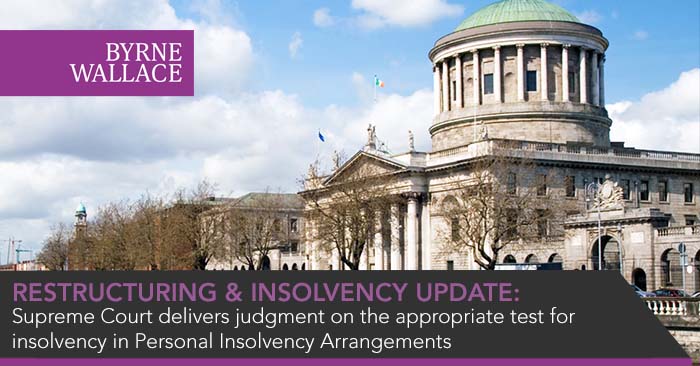Supreme Court delivers judgment on the appropriate test for insolvency in Personal Insolvency Arrangements
Wednesday, 06 December 2023
On 30 November the Supreme Court delivered its written judgment dealing with the correct test for insolvency when considering the eligibility of a debtor for a Personal Insolvency Arrangement (PIA) under the Personal Insolvency Act 2012 (as amended).
Background
One of the qualifying criteria for a PIA is that the debtor must demonstrate that the debtor is “insolvent” within the meaning of section 2(1) of the Personal Insolvency Act 2012. That provision defines the term as meaning “that the debtor is unable to pay his or her debts in full as they fall due”.
In this particular case1, the debtor was a farmer, who was indebted to the appellant, by far his largest creditor, in the amount of €875,000 approximately. However, the uncontroverted evidence also disclosed that the Debtor had very substantial assets, which gave rise to a positive net asset position of somewhere between approximately €600,000.00 and an amount well in excess of €1,000,000.00. These assets included extensive farmland in County Wexford, the majority of which are not subject to any legal charge. These properties comprise the family home of the Debtor, a substantial rental property and agricultural land totalling approximately 190 acres.
The PIA did not require the debtor to dispose of any assets whatsoever. The Appellant contested the approval application initiated under section 115A(9) of the Personal Insolvency Act 2012 (as amended) on the basis that the Debtor did not meet an essential requirement for the proposal of a PIA, being that prescribed by section 91(1)(d) of the 2012 Act, i.e. that the relevant debtor is “insolvent”.
The key findings of general application to other PIAs in the written judgment, delivered by Ms. Justice Baker, are as follows:
Test for Insolvency
The Court affirmed that the solvency of a debtor is to be assessed on a cashflow basis. Ms. Justice Baker elaborated that “The test for insolvency is not so narrow as to mean that a debtor is insolvent if he or she cannot pay liabilities as they fall due from immediately accessible or available cash assets. The legislation envisages an inability to pay in the broad sense and requires an assessment of available assets and whether they can in fact be used to pay a due liability. The test is one of timing and of the nature of the assets.” She summarised the position as follows: “To summarise, a debtor ought not to be considered to be insolvent, even where his cashflow does not allow him to meet his current liabilities, provided that he has assets which could be sold without legal impediment in relatively short order. This is particularly so in respect of assets for which there is an established, liquid market, such as that which exists in real property."
The position with a Principal Private Residence in the assessment of solvency
The written judgment states that “The threshold test is solvency not reasonableness, nor the fact that the sale of a principal private residence might cause hardship to the debtor and his or her family or that alternative accommodation is not available…” and “A general proposition that a principal private residence may not be readily realisable is not borne out by a reading of the legislation……Whether a principal private residence is readily realisable will always be a matter of fact and will depend on factors such as the market for the property in question and the length of time that it is likely to take to sell. The existence of impediments to sale, such as a lis pendens, the refusal of a spouse or civil partner to consent to sale under the Family Home Protection Act 1976, may make a sale difficult or slow the process. More fundamentally the vendor will require possession to sell, and where the creditor is a mortgagee, and unless the debtor consents to deliver up possession, a mortgagee of a principal private residence will require a court order for both possession and sale pursuant to the provisions of Part 3 of the Land Conveyancing and Reform Act 2009 as amended. The mortgagee may, depending on the manner of sale, also need to comply with the requirements of the Central Bank Code of Conduct on Mortgage Arrears. These protections created by other legislation could mean long delays in realising the value of the asset, so that the asset could not be said to be readily realisable.”
The obligations on the Debtor and the Personal Insolvency Practitioner (PIP)
The Court made a number of observations about the manner by which a PIP or debtor is to adduce evidence that would enable a Court to deal with an objection that a debtor did not meet a threshold requirement of insolvency. Ms. Justice Baker stated: “The PIP has an obligation in regard to the threshold requirement that the debtor be insolvent. The burden of proving insolvency lies on the debtor and the PIP in turn must certify to the ISI and to the relevant court that the debtor is indeed insolvent. This is no empty formula, and the PIP is a guardian of the process and has an obligation in taking on the role of independent intermediary to engage with the facts of the case, an obligation that is owed to the ISI, the relevant court, to the debtor and the creditors.”
Comment
This decision brings welcome clarity to secured creditors in particular, who prior to this decision, may have had concerns about the extent to which real property including PPRs could be factored into the solvency analysis when considering eligibility for a PIA.
Comfort will also be taken from the observations surrounding the statutory duty of the PIP to creditors as well as to the debtor and the Court.
ByrneWallace LLP acted for the appellant in this case. Please do not hesitate to contact Partner and Head of Restructuring and Insolvency John Fitzgerald or any member of the Restructuring and Insolvency team for assistance on PIAs or other restructuring matters if needed.
1 Supreme Court Record No: S:AP:IE;2022:000091 [2023]IESC 31

